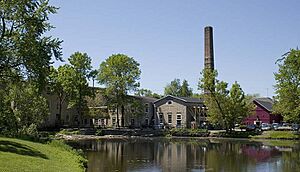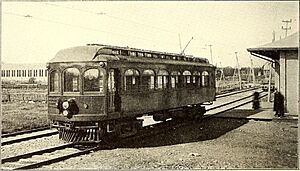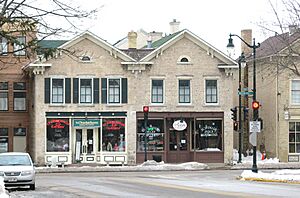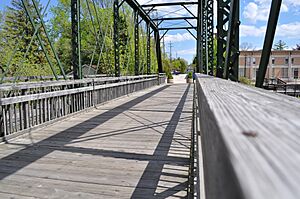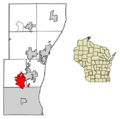Cedarburg, Wisconsin facts for kids
Quick facts for kids
Cedarburg, Wisconsin
|
|
|---|---|
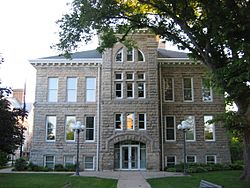
Cedarburg City Hall, located in the Washington Avenue Historic District
|
|
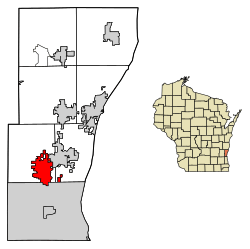
Location of Cedarburg in Ozaukee County, Wisconsin.
|
|
| Country | |
| State | |
| County | Ozaukee |
| Settled | 1840s |
| Incorporated | 1885 |
| Government | |
| • Type | Mayor/Council |
| Area | |
| • Total | 4.88 sq mi (12.65 km2) |
| • Land | 4.84 sq mi (12.52 km2) |
| • Water | 0.05 sq mi (0.12 km2) |
| Elevation | 784 ft (239 m) |
| Population
(2020)
|
|
| • Total | 12,121 |
| • Density | 2,399.30/sq mi (926.40/km2) |
| Time zone | UTC-6 (Central (CST)) |
| • Summer (DST) | UTC-5 (CDT) |
| Zip Code |
53012
|
| Area code(s) | 262 |
| FIPS code | 55-13375 |
| GNIS feature ID | 1562869 |
| Website | ci.cedarburg.wi.us |
Cedarburg is a city in Ozaukee County, Wisconsin, United States. It is about 20 miles (32 km) north of Milwaukee. Cedarburg is a suburb in the Milwaukee metropolitan area. The city became an official city in 1885. In 2020, about 12,121 people lived there.
Cedarburg started as a mill town, like many other places in Ozaukee County. German immigrants built mills powered by water along Cedar Creek in the 1840s. These mills helped the community grow. The area around the mills is now downtown Cedarburg. Until the early 1900s, Cedarburg had a strong German culture. There were Lutheran churches, a brewery, and a spa resort called Hilgen Spring Park. Many German clubs, like two Turner societies, also existed.
Cedarburg changed a lot after World War II. More people moved to the suburbs. Even though all the mills closed by the 1960s, the city grew quickly. New businesses and neighborhoods were built. Over 200 of Cedarburg's old buildings are still standing. The city has eight places listed on the National Register of Historic Places. Cedarburg is popular with tourists. It hosts many festivals and events all year, bringing visitors from other areas.
Contents
- Why is it Called Cedarburg?
- Cedarburg's Past: A Look at History
- Where is Cedarburg? Geography Facts
- Who Lives in Cedarburg? Population Facts
- Cedarburg's Economy: How People Work
- Cedarburg's Culture and Fun Things to Do
- Learning in Cedarburg: Schools and Education
- Getting Around Cedarburg: Transportation
- Parks and Fun in Cedarburg
- Famous People from Cedarburg
- Images for kids
- See also
Why is it Called Cedarburg?
When the first settlers arrived, they saw many white cedar trees. These trees grew along the banks of Cedar Creek. In 1843, a German-American settler named Frederick Leuning built a cabin. He called his home "Cedarburg," which means "cedar castle" or "fortress of the cedars." In December 1844, the early residents decided to name the community Cedarburg.
Cedarburg's Past: A Look at History
The oldest signs of people in Cedarburg are at the Hilgen Spring Mound Site. This site is in the eastern part of the city, near Cedar Creek. It has three burial mounds built by early Woodland period Mound Builders. In 1968, experts from the Milwaukee Public Museum found human remains and old tools there. They found stone altars, arrowheads, and pottery pieces. Scientists used radiocarbon dating to find out when the mounds were built. They were made around 480 BCE, making them some of the oldest mounds in Wisconsin.
In the early 1800s, Native American tribes lived on this land. These included the Potawatomi and Sauk tribes. In 1833, the Potawatomi gave up their land to the U.S. government. They were asked to leave Wisconsin by 1838. Many Native people moved west. However, some stayed in Wisconsin. They later formed the Forest County Potawatomi Community in northern Wisconsin.
The first white settlement in the Cedarburg area was called "New Dublin." This place later became Hamilton. Joseph Gardenier was the first resident. He built a log cabin on Cedar Creek in 1848. Hamilton became the first stop for stagecoaches traveling between Milwaukee and Green Bay.
Most of Cedarburg's early settlers were German immigrants. Ludwig Wilhelm Groth is often called the first settler of Cedarburg. He bought land in 1842 and started planning the area around Cedar Creek. In 1845, Frederick Hilgen and William Schroeder built a wooden gristmill on Cedar Creek. Eleven years later, they built the five-story stone Cedarburg Mill. This mill became the center of the new community. Five dams and mills were built along the creek. This included the 1864 Hilgen and Wittenberg Woolen Mill. It was the largest woolen mill west of Philadelphia.
In 1870, the Milwaukee and Northern Railway connected Cedarburg to Milwaukee. By 1873, the train line went all the way to Green Bay. This helped Cedarburg grow and become successful. Other nearby towns like Hamilton stayed more rural. Cedarburg officially became a city in 1885. About 1,000 people lived there at that time.
In 1897, the woolen mill bought an electric generator. This brought the first electric light to the town. In 1901, the city built an electric plant. In 1909, the Cedarburg Electric Light Commission was created. It managed the city's power. In 1923, they also took care of water and sewer services. Today, this utility is still in business. It is one of 82 city-owned electric companies in Wisconsin.
In 1907, Cedarburg became a stop on the Milwaukee-Northern interurban passenger line. This was a type of electric train. The company had an office in Cedarburg until the 1920s. Passenger service to Cedarburg ended in 1948. More people started using cars and roads got better.
Cedarburg grew quickly after World War II. The number of people living there increased by over 84% between 1950 and 1960. It went from 2,810 to 5,191 people. During this time, new businesses and housing areas were built.
Where is Cedarburg? Geography Facts
Cedarburg is located at 43°17'56" North, 87°59'13" West. The city covers about 4.87 square miles (12.61 square kilometers). Most of this is land, with a small amount of water. The Village of Grafton is to the east. The City of Mequon is to the south. The Town of Cedarburg is to the north and west.
The city is in an area shaped by glaciers from the last ice age. The soil is a mix of good draining material and loam. Underneath is a layer of glacial till. Most of Cedarburg sits on top of a Silurian limestone deposit. Old quarries in the area, like Groth Quarry, had fossils from ancient reefs. Early settlers used this limestone to build homes. Some of these old limestone buildings are still standing today.
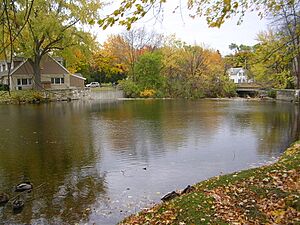
Cedar Creek flows through the city. It runs next to the Washington Avenue historic area. In 1993, the Wisconsin Department of Natural Resources found some pollution in Cedar Creek. The creek is now part of a cleanup effort by the Environmental Protection Agency. Even with cleanup, it's advised not to eat fish caught in the creek downstream from the Bridge Road dam.
Before settlers arrived, the Cedarburg area had thick forests. These forests had American beech and sugar maple trees. White cedars grew along Cedar Creek. Much of the forest was cut down for farming. Today, Cedarburg plants and cares for over 8,000 trees in public areas. The Arbor Day Foundation has named Cedarburg a Tree City USA.
As more land is developed, wild animals sometimes come closer to cities like Cedarburg. You might see white-tailed deer, coyotes, and red foxes in the city. Rarely, black bears have been seen in Ozaukee County. Many birds, like great blue herons and wild turkeys, live in and around Cedarburg. The Cedarburg Bog, north of the city, is an important bird area. A rare plant called Goldenseal grows near the city's northern edge.
The area also has some invasive plants and animals. These include the emerald ash borer (an insect) and plants like common reed and purple loosestrife.
Who Lives in Cedarburg? Population Facts
| Historical population | |||
|---|---|---|---|
| Census | Pop. | %± | |
| 1880 | 945 | — | |
| 1890 | 1,361 | 44.0% | |
| 1900 | 1,626 | 19.5% | |
| 1910 | 1,777 | 9.3% | |
| 1920 | 1,738 | −2.2% | |
| 1930 | 2,055 | 18.2% | |
| 1940 | 2,245 | 9.2% | |
| 1950 | 2,810 | 25.2% | |
| 1960 | 5,191 | 84.7% | |
| 1970 | 7,697 | 48.3% | |
| 1980 | 9,005 | 17.0% | |
| 1990 | 9,895 | 9.9% | |
| 2000 | 10,908 | 10.2% | |
| 2010 | 11,412 | 4.6% | |
| 2020 | 12,121 | 6.2% | |
| U.S. Decennial Census | |||
In 2010, there were 11,412 people living in Cedarburg. There were 4,691 households. About 31% of households had children under 18. The average household had 2.38 people. The average family had 3.00 people.
Most residents (96.3%) were White. About 0.8% were African American, and 1.5% were Asian. About 1.7% of the population was Hispanic or Latino. The average age in the city was 43.1 years old. About 24.7% of residents were under 18. And 16.9% were 65 or older.
Cedarburg's Economy: How People Work
Early Businesses and Mills
Cedarburg's first businesses were mills powered by water. In 1843, Frederick Luening built the Columbia Mill. This was the first mill on Cedar Creek. In 1845, Frederick Hilgen and William Schroeder built another mill. These first mills are no longer standing. But other 19th-century mills still exist. These include the 1853 Concordia Mill and the 1855 Cedarburg Mill. The 1864 Hilgen and Wittenberg Woolen Mill was also important. An old brewery from 1848 is also still standing.
Modern Industries
In the 20th century, Cedarburg had some factories. Carl Kiekhaefer started Mercury Marine in Cedarburg in 1939. This company made boat engines. They had a plant in Cedarburg until 1982. Another company, Amcast, had an aluminum factory until 2005. Both companies had some pollution issues in the past. The U.S. Environmental Protection Agency has worked to clean up these sites.
Today, PartsBadger, an online machining company, was started in Cedarburg in 2016.
Tourism: A Big Draw
The Hilgen and Wittenberg Woolen Mill closed in 1968. It was empty for years. Someone wanted to buy it and tear it down for a gas station. But the mayor at the time, Stephan Fischer, helped save the buildings. William Welty bought some buildings and opened a restaurant. Jim Pape bought the mill buildings by the creek and opened a winery. This area is now called the Cedar Creek Settlement. It has shops, studios, and restaurants.
This helped start a tourism boom in Cedarburg. More art galleries, studios, and souvenir shops opened. Local business groups started weekend festivals. These events bring many people to the city. Cedarburg hosts several festivals each year. These include the Winter Festival in February and the Strawberry Festival in June. There's also the Wine and Harvest Festival in September and Oktoberfest in October. Christmas events happen in November and December. In the summer, there are free concerts called Summer Sounds at Cedar Creek Park.
Many Cedarburg residents work outside the city. They travel to jobs in other areas. This is common in Ozaukee County.
| Largest Employers in Cedarburg, 2013 | |||
|---|---|---|---|
| Rank | Employer | Industry | Employees |
| 1 | Cedarburg School District | Schools | 100–249 |
| 2 | City of Cedarburg | City Government | 100–249 |
| 3 | BMO Harris Bank | Banking | 100–249 |
| 4 | Olsen's Piggly Wiggly | Grocery Store | 100–249 |
| 5 | Cedar Springs Health & Rehabilitation | Nursing Care | 100–249 |
| 6 | Carlson Tool and Mfg Corp. | Making Industrial Molds | 100–249 |
| 7 | Kemps Dairy | Milk Processing | 50–99 |
| 8 | Advanced Technology International | Making Metal Products | 50–99 |
Cedarburg's Culture and Fun Things to Do
The first German settlers still influence Cedarburg today. There are six Lutheran churches in the community. Trinity Lutheran Church was founded in 1843 by German immigrants. Many old buildings have German words carved into them. The oldest gravestones in cemeteries are in German. The Zur Ruhe Cemetery means "to rest" in German.
Cedarburg Public Library
The Cedarburg Women's Club started the city's public library in 1911. The library has about 72,000 items. It also offers digital resources and study rooms. It is part of the Monarch Library System. This system includes libraries in Ozaukee, Sheboygan, Washington, and Dodge counties.
Events and Festivals
Cedarburg hosts the Ozaukee County Fair at Firemen's Park. The fair has been held every year since 1859. It is free to enter. It has live music, truck pulls, rides, and animal shows.
Firemen's Park also hosts four "Maxwell Street Days" flea markets each summer. These markets raise money for the Cedarburg Fire Department. Up to 600 sellers can have tables at these markets.
The city has five main weekend festivals. These include the Winter Festival in February, Strawberry Festival in June, and Wine and Harvest Festival in September. There's also a German-themed Oktoberfest in October. Christmas events happen in November and December. In summer, local companies sponsor a concert series called Summer Sounds at Cedar Creek Park.
Museums to Explore
- Cedarburg Art Museum: This museum is in an old mansion from 1898. It has a collection of forty-nine artworks. It also shows special temporary art exhibits.
- Cedarburg History Museum: This museum tells the story of Cedarburg. It is in the old Hilgen & Schroeder Mill Store. The building also has the Cedarburg Visitor Center. You can see a display of an early 1900s general store.
- Kuhefuss House Museum: This museum is in the Washington Avenue Historic District. It is an old house from 1849. You can take tours to learn about early life in Cedarburg.
- Wisconsin Museum of Quilts & Fiber Arts: This museum is on an old farm from the 1850s. It opened in 2001. It has over 8,000 pieces of art. The museum teaches about fiber arts, like quilting.
Performing Arts and Entertainment
- Cedarburg Cultural Center: This center is on Washington Avenue. It hosts live performances and art shows. It also offers art classes. The Kuhefuss House Museum is part of it.
- Cedarburg Performing Arts Center: This is a large theater with 580 seats. It is connected to Cedarburg High School. It brings in different artists for shows.
- Rivoli Theatre: This movie theater opened in 1936. It is an Art Deco style cinema on Washington Avenue. It has one screen.
Places of Worship
Cedarburg has at least six Lutheran churches. There are also a Methodist church, a Christian Scientist church, and a Baptist church. The Roman Catholic St. Francis Borgia parish is in Cedarburg. There is also the St. Nicholas Orthodox Church. The Alliance Bible Church is just outside the city limits.
Learning in Cedarburg: Schools and Education
Cedarburg's public schools are run by the Cedarburg School District. The district has three elementary schools for kindergarten through fifth grade: Parkview, Thorson, and Westlawn. Each school serves a different part of the city. Webster Middle School serves all students in grades six through eight. Cedarburg High School is for grades nine through twelve.
The school district serves Cedarburg city and town. It also includes parts of Mequon and Grafton. A seven-member school board leads the district. The district also has a superintendent. Todd Bugnacki has been the superintendent since 2015.
The Cedarburg School District is often listed as one of the best schools in Wisconsin.
The city also has two parochial schools. These are private schools with religious connections. They serve students from kindergarten through eighth grade. They are First Immanuel Lutheran School and St. Francis Borgia Catholic School.
Getting Around Cedarburg: Transportation
Cedarburg is about three miles west of Interstate 43 exit 89. The city is also south of where Wisconsin Highway 60 and Washington Avenue meet.
Cedarburg has some public transportation. Ozaukee County and Milwaukee County run the Route 143 commuter bus. This bus goes to Milwaukee using Interstate 43. It stops at a park-and-ride lot near Cedarburg's highway exits. The bus runs mostly during morning and evening rush hours on weekdays. Ozaukee County Transit Services also has a Shared Ride Taxi. This taxi service can take you to places not on the bus route. It runs seven days a week.
Cedarburg has sidewalks in most areas. It also has the Ozaukee Interurban Trail. This trail is for walking and biking. It connects Cedarburg to nearby towns like Grafton and Mequon. The trail goes north to Sheboygan County and south to Milwaukee County.
Cedarburg grew partly because of its train connections in the 1800s. From 1907 to 1948, an interurban passenger train connected Cedarburg to Milwaukee and Sheboygan. This train line was later turned into the walking and biking trail in the 1990s. Today, the Wisconsin Central Ltd. railroad provides freight train service to Cedarburg. While Cedarburg no longer has passenger trains, you can catch an Amtrak passenger train in nearby Milwaukee.
Parks and Fun in Cedarburg
The City of Cedarburg has 34 parks. These parks cover a total of 146 acres. They range from small parks like Doctor's Park (0.1 acre) to larger ones like Centennial Park (23 acres). Centennial Park has a public pool, two ponds, a sledding hill, and a playground for children with disabilities.
The Ozaukee Interurban Trail runs through Cedarburg. It follows the path of an old electric train line. The trail starts in Brown Deer to the south. It connects to the Oak Leaf Trail. The trail goes north to Oostburg in Sheboygan County. The Cedarburg part of the trail was finished in 1996. It connects the city to Grafton and Mequon.
Cedarburg also has many private places for fun. These include a golf course, two bowling alleys, and several gyms. There is also the Milwaukee Curling Club, a gymnastics center, a roller rink, and the Ozaukee Ice Center. The Ice Center is open all year for hockey and ice skating.
Famous People from Cedarburg
- Jesse Anderson, convicted murderer
- Paul Clement, 43rd Solicitor General of the United States
- Jacob Dietrich, Wisconsin legislator
- Gregory Euclide, visual artist
- Janine P. Geske, Justice of the Wisconsin Supreme Court
- Amadeus William Grabau, geologist and paleontologist
- Frederick W. Horn, Wisconsin legislator
- Edward H. Janssen, Treasurer of Wisconsin
- Eric Larsen, polar explorer
- Clarence Kenney, football player
- Peter F. Leuch, Wisconsin legislator
- Edna Scheer, All-American Girls Professional Baseball League player
- John Schuette, Wisconsin State Senator
- Jonathan Stiever, baseball player
- Ralph E. Suggs, U.S. Navy admiral
- Josh Thompson, country singer
- Jason Upton, Christian singer/songwriter
Images for kids
See also
 In Spanish: Cedarburg (Wisconsin) para niños
In Spanish: Cedarburg (Wisconsin) para niños



